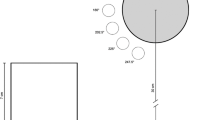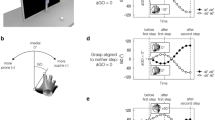Abstract
When humans grasp an object off a table, their digits generally move higher than the line between their starting positions and the positions at which they end on the target object, so that the digits’ paths are curved when viewed from the side. We hypothesized that this curvature is caused by limitations imposed by the environment. We distinguish between local constraints that act only at the very beginning or the very end of the movement, and global constraints that act during the movement. In order to find out whether the table causes this vertical curvature by acting as a global constraint, we compared grasping a target object positioned on a table with the same task without the table. The presence of the table did not affect the vertical curvature. To find out whether constraints at the beginning and end of the movement cause the vertical curvature, we manipulated the constraints locally at those positions by letting the subject start with his digits either above or below the end of a rod and by attaching the target object either to the top or to the bottom of another rod. The local constraints at the start of the movement largely explain the vertically curved shape of the digits’ paths.







Similar content being viewed by others
References
Baker JT, Donoghue JP, Sanes JN (1999) Gaze direction modulates finger movement activation patterns in human cerebral cortex. J Neurosci 19(22):10044–10052
Borchers S, Himmelbach M (2012) The recognition of everyday objects changes grasp scaling. Vis Res 67:8–13
Flash T (1987) The control of hand equilibrium trajectories in multijoint arm movements. Biol Cybern 57(4–5):257–274
Flash T, Hogan N (1985) The coordination of arm movements: an experimentally confirmed mathematical model. J Neurosci 5(7):1688–1703
Haggard P, Wing A (1997) On the hand transport component of prehensile movements. J Mot Behav 29(3):282–287
Harris CM, Wolpert DM (1998) Signal-dependent noise determines motor planning. Nature 394:780–784
Jakobson LS, Goodale MA (1991) Factors affecting higher-order movement planning: a kinematic analysis of human prehension. Exp Brain Res 86(1):199–208
Jeannerod M (1981) Intersegmental coordination during reaching at natural visual objects. In: Long IJ, Baddeley A (eds) Attention and performance IX. Lawrence Erlbaum, Hillsdale, pp 153–169
Jones KE, de Hamilton AFC, Wolpert DM (2002) Sources of signal-dependent noise during isometric force production. J Neurophysiol 88(3):1533–1544
Marteniuk RG, Ivens CJ, Bertram CP (2000) Evidence of motor equivalence in a pointing task involving locomotion. Mot Control 4(2):165–184
Morasso P (1981) Spatial control of arm movements. Exp Brain Res 42(2):223–227
Papaxanthis C, Pozzo T, McIntyre J (1998) Hand trajectories of vertical arm movements in one-G and zero-G environments. Exp Brain Res 120(4):496–502
Papaxanthis C, Pozzo T, Schieppati M (2003) Trajectories of arm pointing movements on the sagittal plane vary with both direction and speed. Exp Brain Res 148(4):498–503
Pinter IJ, van Soest AJ, Bobbert MF, Smeets JBJ (2012) Do we use a priori knowledge of gravity when making elbow rotations? Exp Brain Res 217(2):163–173
Rosenbaum DA, Meulenbroek RJG, Vaughan J, Elsinger C (1999) Approaching grasping from different perspectives. Mot Control 3(3):289–297
Rosenbaum DA, Meulenbroek RJ, Vaughan J, Jansen C (2001) Posture-based motion planning: applications to grasping. Psychol Rev 108(4):709–734
Saling M, Alberts J, Stelmach GE, Bloedel JR (1998) Reach-to-grasp movements during obstacle avoidance. Exp Brain Res 118(2):251–258
Schillings JJ, Meulenbroek RGJ, Thomassen AJWM (1996) Decomposing trajectory modifications: pen-tip versus joint kinematics. Handwriting and drawing research: basic and applied issues. IOS Press, Amsterdam
Schmidt RA, Zelaznik H, Hawkins B, Frank JS, Quinn JT (1979) Motor-output variability: a theory for the accuracy of rapid motor acts. Psychol Rev 86(5):415–449
Smeets JBJ, Brenner E (1999) A new view on grasping. Mot Control 3(3):237–271
Smeets JBJ, Brenner E (2001) Independent movements of the digits in grasping. Exp Brain Res 139(1):92–100
Tresilian JR, Stelmach GE (1997) Common organization for unimanual and bimanual reach-to-grasp tasks. Exp Brain Res 115(2):283–299
Ustinova KI, Perkins J, Szostakowski L, Tamkei LS, Leonard WA (2010) Effect of viewing angle on arm reaching while standing in a virtual environment: potential for virtual rehabilitation. Acta Psychol 133(2):180–190
Verheij R, Brenner E, Smeets JBJ (2012) Grasping kinematics from the perspective of the individual digits: a modelling study. PLoS One 7(3):e33150
Wolpert DM, Ghahramani Z, Jordan MI (1994) Perceptual-distortion contributes to the curvature of human reaching movements. Exp Brain Res 98(1):153–156
Zoia S, Pezzetta E, Blason L, Scabar A, Carrozzi M, Bulgheroni M, Castiello U (2006) A comparison of the reach-to-grasp movement between children and adults: a kinematic study. Dev Neuropsychol 30(2):719–738
Acknowledgments
This work was supported by a grant from the Netherlands Organization for Scientific Research, NWO Vici grant 453-08-004.
Author information
Authors and Affiliations
Corresponding author
Appendices
Appendix 1
In this design, each condition was presented first to 3 subjects, second to 3 subjects, third to 3 subjects and so on. The order of the conditions was also counterbalanced as far as possible. For example, condition ‘table’ followed condition ‘all up’ 7 times and followed condition ‘all down’ 8 times. Each subject performed each condition twice, once in the first 3 blocks and once in the second 3, with no condition being repeated in the third and fourth block (Table 3).
Appendix 2
The model presented by Smeets and Brenner (1999) is a 2-D minimum-jerk model (Flash and Hogan 1985). It models grasping movements by simulating two single-digit pointing movements and combining the outcomes. For each digit and each coordinate of the movement, the following polynomial equation with six constants gives the minimum-jerk trajectory:
The values of the constants follow from six boundary conditions: the initial and final position, velocity and acceleration. To acquire a perpendicular approach to the target surface, a non-zero final deceleration is chosen perpendicular to the surface. The final deceleration is scaled by the squared movement time resulting in the so-called approach parameter, a p . The larger this parameter, the more perpendicular the simulated digit’s path approaches the target surface. The movement time (MT) does not affect the digits’ paths and can thus be chosen independently.
We expanded the model of Smeets and Brenner by adding a polynomial equation for the vertical movement, making it a 3-D minimum-jerk model. We chose the following boundary conditions for this extra polynomial equation.
The strength of the effect of the local constraints at the start is set by the parameter a cs , which is positive when simulating movements in which the starting position was above the start-beam and negative when simulating movements in which the starting position was below the start-beam. The strength of the effect of the local constraints at the end is set by the parameter a ce , which is positive when simulating movements in which the tealight was above the end-plate and negative when simulating movements in which the tealight was below the end-plate. Like a p , the parameters a cs and a ce have the dimension of length. The boundary conditions that we chose result in the following values for the constants of Eq. 1:
In the simulation of our experiment, we used a magnitude of 1.5 m for the parameter values of a p , a cs and a ce . We did not tune the parameter values to our experimental results; 1.5 m was the value used in the paper of Smeets and Brenner (1999) as a typical value for a p .
Appendix 3
In the original model of Verheij et al. (2012), the tips of the index finger and the thumb are modeled as point masses moving in a force field. We refer to these point masses as ‘tips’. The force field is the sum of multiple forces. Each force represents one or two objectives. The implemented objectives for each tip are the following: arrive at the preselected goal position, avoid collisions with positions other than the goal position, limit the distance to the other tip, arrive at approximately the same time as the other tip and move smoothly. The table is considered as an obstacle throughout the movement; hence, there is a repulsive force from the table on which the target object is placed. To a large extent, the repulsive force from the table causes the height of the digits’ paths. Avoiding collisions with positions on the surface of the target object other than the goal position causes the remainder of the vertical curvature.
In the revised model, the table has no influence on grasping kinematics. Instead, we considered the start-beam as an obstacle. The length of the start-beam is 4.5 cm, and its width is 4.4 mm. In the simulation, the tips started 0.1 mm above the start-beam, 0.1 mm from each other laterally and 1 cm from the end of the rod. The simulation ended when the tip representing the thumb was at a distance of 0.1 mm from its goal position. We used the same set of parameter values as in the paper in which the original model was introduced (Verheij et al. 2012), with the one difference that the parameter R t (indicating the repulsiveness of the table) was zero.
Rights and permissions
About this article
Cite this article
Verheij, R., Brenner, E. & Smeets, J.B.J. Why are the digits’ paths curved vertically in human grasping movements?. Exp Brain Res 224, 59–68 (2013). https://doi.org/10.1007/s00221-012-3288-0
Received:
Accepted:
Published:
Issue Date:
DOI: https://doi.org/10.1007/s00221-012-3288-0




